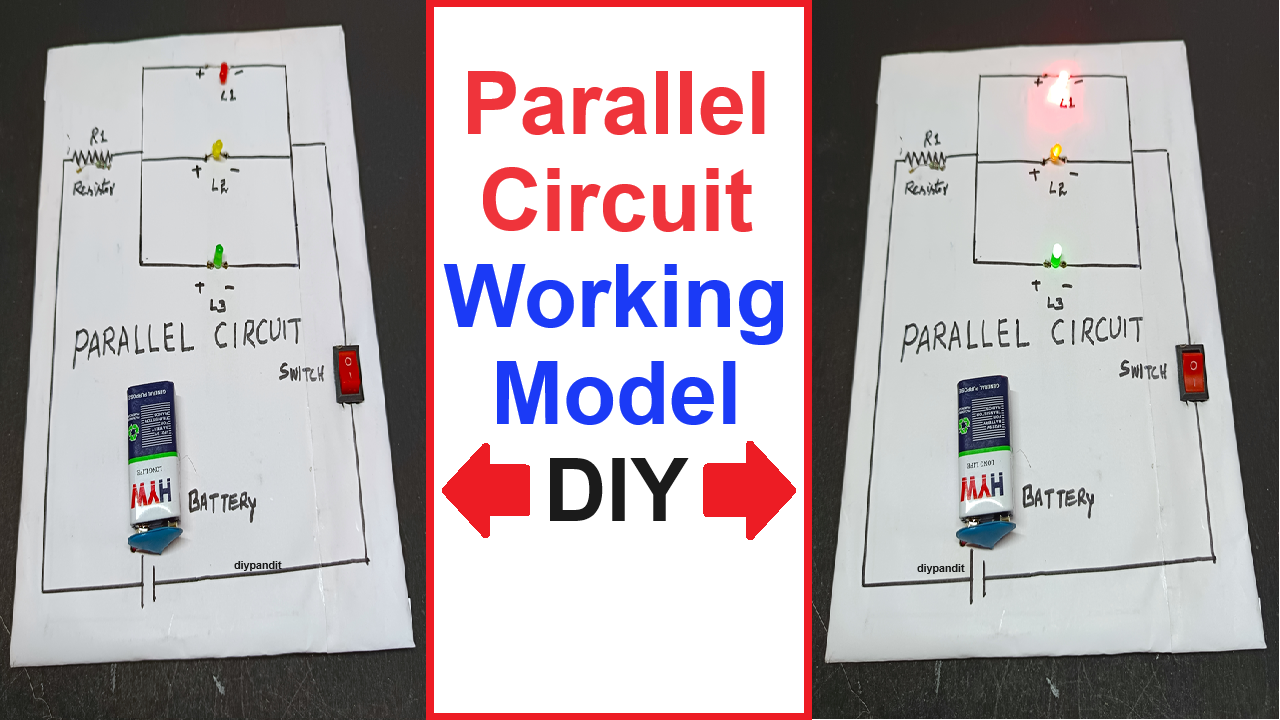Creating a parallel circuit model using resistors, three colored LED lights, a switch, and a 9V battery mounted on cardboard can be an excellent way to understand and demonstrate the principles of parallel circuits.

Here’s a step-by-step guide to building this model:
Materials Required:
- Cardboard (for the base)
- Three colored LED lights (red, green, blue)
- Three resistors (appropriate value for LEDs)
- 9V battery
- 9V battery holder
- Switch
- Wires
- Soldering iron and solder (optional)
- Alligator clips (optional)
- Glue or tape
- Scissors or a utility knife
- Markers or pens
- Wire cutters/strippers
Step by Step Video Instructions:
Step 1: Prepare the Cardboard Base
- Cut the Base: Cut a piece of cardboard to a suitable size to hold your circuit components.
- Label the Components: Mark positions for the battery, switch, resistors, and LEDs on the cardboard.
Step 2: Set Up the Components
- Battery Holder: Attach the battery holder to the cardboard at the marked position.
- Switch: Attach the switch to the cardboard at its marked position. Ensure it is easily accessible.
- LEDs: Insert the three LEDs into the cardboard at the marked positions. You can use small holes to hold them in place.
- Resistors: Attach each resistor to the cardboard, one for each LED, near their marked positions.
Step 3: Connect the Circuit
- Connect the Battery to the Switch: Connect the positive terminal of the battery holder to one terminal of the switch using a wire.
- Connect the Switch to the Resistors: Connect the other terminal of the switch to one end of all three resistors. This is where the resistors will branch out from the switch.
- Connect the Resistors to the LEDs: Connect the other end of each resistor to the anode (long leg) of each LED. Each resistor should be connected to a separate LED.
- Connect the LEDs to the Battery: Connect the cathode (short leg) of each LED to a common wire, and then connect this wire to the negative terminal of the battery holder. This creates the parallel connection where each LED has its own path to the battery.
Step 4: Secure the Connections
- Check Connections: Ensure all connections are secure. You can use solder for permanent connections or alligator clips for temporary connections.
- Insulate Exposed Wires: Use electrical tape to insulate any exposed wires to prevent short circuits.
Step 5: Test the Circuit
- Insert the Battery: Place the battery in the battery holder.
- Operate the Switch: Flip the switch to turn on the circuit. All three LEDs should light up independently. If they do not, check the connections and ensure all components are properly connected.
Explanation
- Battery: Provides the voltage needed to power the circuit.
- Switch: Controls the flow of electricity, allowing you to turn the circuit on and off.
- Resistors: Limit the current flowing through each LED to prevent them from burning out.
- LEDs: Emit light when current flows through them. In a parallel circuit, each LED operates independently.
- Cardboard Base: Provides a stable platform to mount and organize the components.
This project effectively demonstrates how a parallel circuit works, with each component operating independently, providing a clear visual aid for understanding parallel connections.

